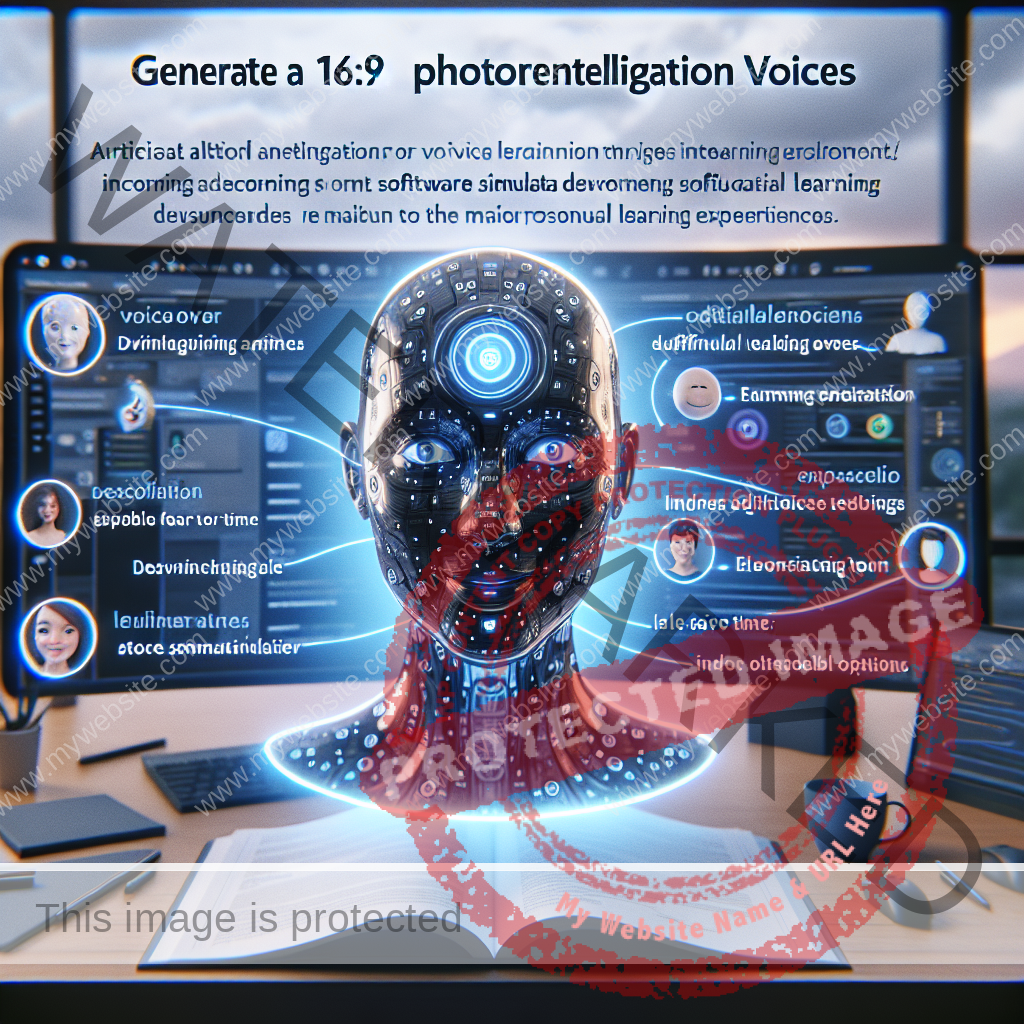Reading Time: 6 minutes
<h2>The Power of AI Voices: A Dive into Enhancing Learning Experiences</h2>
As an experienced eLearning developer, I've been on quite the journey—transforming complex subjects into engaging and interactive experiences for learners. Recently, I stumbled across an enlightening blog post titled <a href="https://elearning.adobe.com/2025/04/using-ai-voices-in-adobe-captivate-for-software-simulation-demos/" target="_blank"><b>Using AI Voices in Adobe Captivate for Software Simulation Demos</b></a>, written by Paul Wilson. The insights in this article resonated with me, as they explore the realm of AI voices in eLearning, an area I believe can revolutionize how we engage users.
Paul's experience, with nearly two decades in eLearning design, adds substantial credibility to the dialogue surrounding AI voices. He shares how AI technology, particularly in tools like Adobe Captivate, is transforming the landscape of software simulations. This is not merely a trend; it's a fundamental shift towards creating more dynamic and realistic learning environments.
One highlight from the article is the discussion on how AI voices can humanize digital content. As someone who emphasizes learner engagement in all of my projects—especially those built using Articulate Storyline 360 and Rise—I can’t emphasize enough the difference a relatable voice can make. Realistic AI voices can create a sense of presence in the virtual classroom, breaking the barrier between the learner and the material. I’ve often found that when a course has a personable narration style, learners are more likely to stay focused and absorb the information being presented.
Moreover, Paul mentions that using AI voices can streamline production time significantly. Gone are the days when I spent countless hours recording and editing audio tracks for my courses. With AI voices, I can generate voiceovers in minutes, allowing me more freedom to iterate on course design and innovation. My team can focus on engaging content rather than the minutiae of audio production. This efficiency translates to faster course rollouts for clients, a key benefit for businesses looking to enhance their training portfolios.
AI voices also promote inclusivity. Different learning styles and preferences mean that traditional text-based approaches may not serve every learner equally. Integrating AI voice options enables the customization of content delivery, which can lead to improved learner outcomes. As an advocate for diversity in learning, I'm excited about the potential these technology-driven solutions present.
That being said, I also recognize the importance of maintaining a human touch. AI technology should augment rather than replace human interactions. While AI voices can enhance learning experiences, they should be woven into a larger narrative that includes the human elements of teaching—such as mentorship and peer collaboration. Striking a balance is essential for ensuring educational experiences are holistic.
In my own projects, I’ve started implementing AI voice options alongside traditional voiceovers in some cases, allowing learners to choose their preferred narration style. Feedback has been overwhelmingly positive! They appreciate having options to tailor their learning experience to their individual preferences, and it has boosted overall engagement.
If you're considering incorporating AI voices in your courses and looking for ready-made solutions, I encourage you to check out my <a href="https://an802adam.biz/all-courses/" target="_blank"><b>Prebuilt Courses</b></a> section. These courses can be customized based on over 20 topics, ensuring that you can offer a robust portfolio of online courses tailored to your audience's needs.
<h2>Driving Engagement with AI Voice Integration in Adobe Captivate</h2>
The potential for AI voices to drive engagement in eLearning is monumental—you can't underestimate the impact a well-articulated voice can have on a learner's journey. Paul Wilson speaks to this point when he addresses how AI voices can be seamlessly integrated into Adobe Captivate for software simulations.
Leveraging tools like Adobe Captivate allows developers to create interactive scenarios where learners can interact with the content in real time, making the experience feel authentic and immersive. When AI voices narrate instructional prompts or guidance within simulations, it leads to a more cohesive experience. Rather than just consuming information, learners can engage and apply their skills in a guided, supportive environment.
I recall a specific training project where we used AI voices for a software demo. The learner experience improved remarkably—instead of a monotonous voice droning through instructions, the AI voice dynamically adjusted its tone to match different scenarios, holding the learner's attention. They reported feeling more confident navigating complex software applications because they felt "guided" rather than "told." That's the power of engagement that AI voices can facilitate!
Paul also highlights AI voice customization, mentioning that developers can modify accents, emotions, and speed to suit diverse learning preferences. With tools like Articulate Storyline 360, we can easily insert AI-generated audio clips that enhance our learning modules. This is a game changer when considering the varied learning environments we often work in.
It’s essential to remember that while AI can help gauge user responsiveness and adapt accordingly, the personal touch in our eLearning content cannot be overlooked. Each learner brings unique experiences and backgrounds to their learning journey, and our courses should reflect that diversity. Inclusion in voice options, as Paul mentions, can create a more welcoming environment for learners of all backgrounds.
In addition, AI voices can support real-time feedback mechanisms. For example, integrating AI voice prompts during assessments can improve a learner's ability to process information while being actively engaged. This enhances retention, making the learning experience not just informational but transformative.
For those in the industry looking to harness AI technology effectively without sacrificing quality, it may also be worthwhile to explore platforms that specialize in producing AI voice options. Many developers and institutions are adopting these technologies, and staying ahead of the curve could position you as a leader in your field.
<h2>Future Trends in eLearning: The Role of AI Voices</h2>
The future of eLearning is intertwined with AI technology, particularly as companies scramble to create more efficient and engaging training programs. Paul Wilson's article presents a thought-provoking examination of this landscape, which I've found both insightful and motivational.
One trend that's gaining traction is the integration of AI voices into various learning management systems (LMS). As more institutions look to streamline their training processes, tools that allow for easy implementation of AI voices will become essential. After all, an engaging course will lead to higher completion rates and improved skills application in real-world settings.
Furthermore, as AI voices become more sophisticated, they will likely evolve into even more contextually-aware entities—able to adjust tone and pacing based on learner feedback and interaction. This could revolutionize how adaptive learning scenarios are created, allowing for a genuinely tailored educational experience that keeps learners engaged and motivated.
It's also worth noting that many organizations are extending their emphasis on soft skills training. AI voices can play a pivotal role in creating scenarios that help maintain empathy and understanding during conversations, which is vital in roles that require interpersonal skills. Drawing from my own experiences, I see this trend as a significant move toward more comprehensive training practices in professional settings.
Moreover, the impact of interests like augmented reality (AR) and virtual reality (VR) in eLearning cannot be ignored. As AI voices become integrated into AR/VR environments, the immersive experience can take learners to entirely new levels of engagement. Imagine a training simulation where AI voices guide you through a virtual workspace while providing real-time feedback—this could redefine training effectiveness.
As we continue to embrace these advancements within the eLearning industry, it’s crucial to remain curious and open-minded. Paul Wilson's insights are a valuable reminder that as professionals, we must continually adapt, innovate, and explore new ways to serve our learners better.
To explore more on this topic, you can visit the original article here: <a href="https://elearning.adobe.com/2025/04/using-ai-voices-in-adobe-captivate-for-software-simulation-demos/" target="_blank">[original title]</a>.















